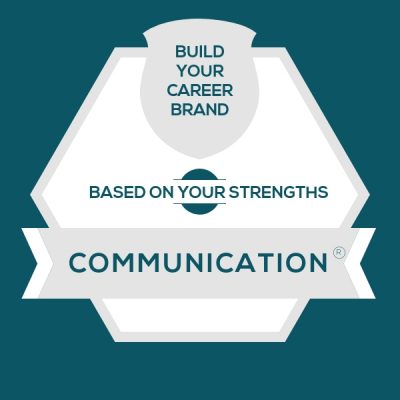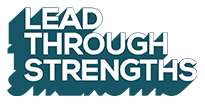Communication Strength – Build A Genuine Career Brand
Podcast: Play in new window
Subscribe: Spotify | iHeartRadio | Email | TuneIn | More

Communication Strength: Get Known For Your Talent
I hear a lot of reflections about how to apply your CliftonStrengths talent theme of Communication to your career.
In this series, you get one strength per post so that you can add to the insights from your StrengthsFinder report and make an even stronger alignment between your current job and your strengths.
- If you’re exploring this concept as a manager, use this series for career development ideas and even new clues about responsibilities you could give a person with this talent theme so that they can show up at their best.
- If you’re exploring this concept for yourself, use this as a chance to build a reputation for your strengths so that you’re more likely to be given assignments that live in your strengths zone.
Today's episode talks about the Communication strength.
You’ll get three layers to chew on:
1. Career Branding
2. Red Flag Situations At Work
3. Fresh Application Ideas
Career Branding For The Communication Strength
You probably already have a reputation for what you know. Think about your personal resume, CV, or your LinkedIn profile, I bet it's full of “the what,” which are things like job titles, skills, knowledge, expertise, or the degree you earned. What’s missing is usually "the how,” and this is where your StrengthsFinder talent themes live.
Chances are good that you are a lot like my StrengthsFinder training clients, where you don’t physically see your teammates and customers every day. So many of us work on remote teams. That’s why LinkedIn has become so important for career branding. It’s how your teammates, customers, and vendors go look you up before a meeting - to see who they’re about to talk to. And rather than only telling them what you know, you should also give them a peek at how it is to work with you.
Here are a bunch of adjectives to consider using in your career branding efforts and your LinkedIn profile when you lead through the Communication strength:
- Presenter
- Transparent
- Eloquent
- Captivating
- Expressive
- Clever
- Nuanced
- Conversationalist
- Entertainer
- Chatty
- Collaborative
- Poignant
- Vocal
- Word Nerd
- Explainer
- Evocative
- Witty
- Storyteller
- Writer
- Interactive
Red Flag Situations When You Lead With The Communication Strength
These are the cultures, interactions, or situations that might feel like soul-sucking drudgery to someone with the Communication strength. They could even make you want to quit the team if they get really bad. So I’ll give you a couple of these to be on watch for — because if they fester, you might become detached or disengaged at work.
Here are a couple of Red flags for the Communication strength (talent theme):
-
Dismissive About Words. If you lead through the Communication strength, you believe that words carry truth. They matter, big time. Having your expression squashed or shut down will be draining. Seeing others get shut down will also feel draining. If someone keeps telling you to stick to the facts, and ditch the nuanced descriptors, you will likely feel handcuffed at work.
-
Don’t Talk It Out. If you’re in a place where you’re expected to fully vet your ideas and think them through before expressing them, you may feel like you’re not at your best. If you lead through the Communication strength, your best ideas often happen while you’re talking out an idea…live! If you’re in a quiet, keep-to-yourself environment, it might feel stifling to you.
3 Fresh Application Ideas For The Communication Strength
These are ways to apply the Communication strength at work, even when the job duties on the team feel pretty locked in. If you’re exploring this concept as a team manager, be sure to have a conversation around these ideas. You’ll both be able to come up with places to apply them.
For someone who leads through the Communication strength, put the talent to good use with one of these options:
-
Volunteer To Give Presentations. You can become known as someone who captivates others. This may be through the colorful, charismatic way that you present. Or, it can be that you’re utterly compelling because of the way you craft the story arc.
-
Invest In A/B Testing. Although you may love to improvise because you’re a natural communicator, the extreme strength in communication happens when you focus on craftsmanship. Give a presentation with 3 different metaphors. Or try 3 different attention grabbers to kick it off. As you watch people respond, you’ll learn a lot about which nuance lands with your audiences.
-
Borrow From Hollywood. Think of your favorite movie plot. Re-watch the film to study how they reveal each new twist. Jot down ideas for how you can use similar techniques at work to deliver a training topic or to communicate a customer message. Experiment with ways to remix their techniques for building tension, surprise, and contrast. Use them at work to keep your audience on the edge of their seat – even if it’s just for an email.
Here's Your Personal Branding Homework For The Communication Strength
- Go take action on your LinkedIn profile with the career branding section. Challenge yourself to write one sentence in the About section of LinkedIn that captures how you collaborate as a teammate at work.
- Then think over the red flags to see if there’s anything you need to get in front of before it brings you down. You might decide to make the situation mean something different, or pre-plan a reaction for the next time it comes around.
- Volunteer your talents through the application ideas. If you’re a manager, have a conversation with your team members about which of these things sound like something they’d love to have more of.
- Dig into the Communication strength all the way. You can really nerd out on the nuances on the Communication Talent Theme Page.
Here's A Full Transcript Of The 10 Minute Episode
You're listening to Lead Through Strengths, where you'll learn to apply your greatest strengths at work. I'm your host, Lisa Cummings and I got to tell you, it's tough to find something more energizing than using your natural talents and strengths every day at work.
Today, we're talking Communication, and I hear a lot of nuanced questions about how to align your CliftonStrengths talent theme of Communication. People say, “Is it written word?”, “Is it spoken word?”, “Is it that I'm a good presenter at work? What does it mean?”
Well, in this series, we're going to break this strength down and allow you to add those insights from the StrengthsFinder report and find that the answer is, “Yeah, it's all of those things or any of those things.” But this will give you a more practical way to make a match between some of the things you read about and the actual job duties that you do.
Now, if you're listening from a manager perspective, and you manage someone with this talent theme, then use this to get ideas about tasks and responsibilities that would align really well to help this person invest in that theme, and make it great. If you're listening for yourself, because you lead through the theme of Communication, use it as a chance to build a reputation around the strength so that you get asked to do more responsibilities that align with your natural talents.
Today, with this talent theme focus on Communication, we're talking three layers. One, career branding. Two, red flags to watch out for. And number three, application ideas.
[1:39] So, let's talk career branding first. We know that you probably have a reputation for what you've done on the job, knowledge, skills, subject-matter expertise, functional areas that you work in, companies that you work for, all these things that live in the ‘what’ - what you've done or what you know how to do.
Now, this ‘how’ part is the one that is often overlooked, and it can be so much fun if you lead through Communication, to dig into how you communicate, how you interact, how you express decisions, how you influence other people. Imagine those being factored in to the responsibilities that you're given at work.
So, here are some words to consider that might really resonate with you. Presenter. Transparent. Eloquent. Captivating. Expressive. Clever. Nuanced. Conversationalist. Entertainer. Collaborative. Poignant. Vocal. Word Nerd. Explainer. Evocative. Witty. Storyteller. Writer. Interactive.
I gave you lots of different flavors there. So, think about which one really resonated with you as something you want to be known for as you move into the future. Pick that one and make a goal of using that one in your conversations, in your writing all the way down to conversations you're having in meetings, to how you type a response and instant message. Set that intention for being known for leading through that word.
Okay, now let's move to red flag situations. These are the cultures, interactions, situations that really could feel like soul-sucking drudgery to you if you lead through Communication. These are the kind of things that if you let them fester, if you don't get in front of them and learn to manage them, you might get the urge to quit the job or become detached at work.
So, number one red flag, dismissive about words. If you lead your Communication, you believe that words carry truth. You believe that words matter and they matter big time. Having your expression squashed or shut down will feel draining. You watching someone else's expression being squashed or shut down will be draining. If someone keeps telling you to stick with the facts, quit telling stories, ditch the nuance descriptors, you will likely feel handcuffed at work because there's an important layer and nuance about you that you're not able to add to the work.
The second red flag, I'm going to call it, ‘don't talk it out’. If you're in a place where you're expected to fully vet your ideas, think them all the way through before you would express them aloud, you may feel like you're not at your best. If you lead through Communication, often your best ideas are happening while you're talking out an idea life. You probably like to talk it out.
Stream of consciousness works really well for people who lead through Communication. But if you are instead in a quiet, keep-to-yourself environment, that might feel stifling to you. If you've ever heard someone say, -
“Don't want to hear you think through your ideas. I need you to bring the good thinking that you've already done. Don't waste my time with the process.”
Well, see, the process, if you lead through Communication is often where those great ideas come from. It's how they get out of you. So, watch out for this. And one easy way to mitigate that red flag is find the kindred spirit who also needs to talk out ideas aloud.
Alright, next up is fresh application ideas for Communication. These are ways you can apply the talent theme at work even when the job duties seem pretty locked in. And if you're listening as a manager, just have a conversation with the person on your team who leads through Communication to make sure you've found a relevant place to apply them, and you've found the ones that really resonate with the person. If you're listening for yourself, just pick the one that seems most useful to you right now.
The first, volunteer to give presentations. Imagine just taking the reins, becoming known as someone who can captivate others. I talked to a lot of people who wish they could be more influential at work, and because of your knack for Communication. If you're giving more presentations, whether it is formally delivering a people in operations meeting, or you're delivering a lunch-and-learn on a topic that is just fun for you and you wanted to offer it as an extra professional development opportunity for someone on the team, this may be through some of the colorful, charismatic ways that you present, or it could be something like, “wow, they really love the way you craft a story arc”, and you can see how you're carrying people through the process, and it just makes you utterly compelling, get into the craftsmanship of it.
The more you practice, the more you give presentations of different styles to different people, the better you're going to become as you hone this skill.
That leads me to number two, invest in A/B testing. Although you may love to improvise, because a lot of people who lead through Communication do because you're a natural communicator, the extreme strength in this Communication talent theme, it happens when you really nerd out on the craftsmanship. So rather than improvising, like what would probably come first to mind, as I'm just gonna be able to wing this because I'm a good communicator, instead,
Unknown Speaker 7:28
give a presentation, the same one, but as you do it three different times, do it by trying out 3 different metaphors as the thing that carries through, that red thread that carries through the story. Or try 3 different attention grabbers upfront to kick it off and see how people respond. And as you watch the responses, and you see what resonates the most, and you watch how you crafted the storyline that worked in this A/B testing, it's going to tell you the nuance that lands with your audience and the ones that you carry off best.
So, get into the craft like that. It will do a lot for the next level kind of skill instead of just what naturally comes out of you. This is the next level stuff.
Alright, number three, borrow from Hollywood. Just have fun with this one. Think of your favorite movie, one that has a good plot, and then rewatch the film and study how they reveal each twist in the story. Jot down some ideas as you rewatch this movie and then think, -
‘How can I translate those techniques at work, to deliver a training topic, or to communicate a customer message, or just to talk in a meeting or to write a compelling subject line?”
Experiment with ways that you could remix their techniques, to build tension, to build surprise or offer something unexpected that makes a person perked up, or how they deliver contrast.
So, watch it with that very careful eye looking for tension, surprise or unexpectedness and contrast, then use those that work, those techniques to keep your audience on the edge of their seat, even if it's just for the way that you wrote an e-mail.
So, there you have it. It's a quick tour for building your career through the talent theme of Communication. Shout out to Joe Darren for content contributions. And let's get into your homework.
So, take action on career branding. Challenge yourself to write one sentence in the About section of LinkedIn that captures how you collaborate or influence at work.
Then think over those red flags. See if there's anything you need to get in front of before it brings you down.
And finally, volunteer your talents through those application ideas and add to this homework. If you're a manager, make sure you've talked to the person who leads through those themes so that you know it's relevant for them.
With that, I'm your host Lisa Cummings from Lead Through Strengths. Now, if you're thinking about how to build the strengths-based culture over time in your office, head over to leadthroughstrengths.com/training . See if our live virtual training offerings are a good fit for you.
Until next time. Thanks for being part of this powerful strengths movement that helps people unleash the awesomeness already inside them.
Carmie is a professional writer and editor at Lead Through Strengths. Having spent 8 happy years with a nonprofit child organization as a storyteller and sponsorship relations team manager, she continues collaborating with others across the globe for the joy of human development and connection. Her days are powered by coffee, curiosities, cameras (film and digital), music, notebooks, and a cat. Where books are home, she’s home. She calls her Top 5 StrengthsFinder Talents “CLIPS” (Connectedness, Learner, Intellection, Positivity, and Strategic)–you know, those tiny objects that hold connected things together. She’d like to think she’s one.

